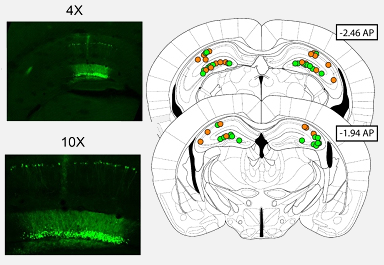
The Robison Lab studies gene transcription and epigenetic regulation in the hippocampus as it relates to three main areas: drug addiction, depression/antidepressant action, and general learning.
General Learning
The grand majority of who and what we are is built throughout our lives through experiences maintained as memories. Consolidation of our explicit memories occurs within a part of the brain’s limbic system called the hippocampus, and it is in this region that the molecular and cellular processes of learning have been most closely studied. We know that connections between hippocampal neurons are formed, eliminated, enhanced, and weakened during memory formation in a process called synaptic plasticity, and we know that some stages of this process involve alterations in the transcription of specific genes. However, the specific transcription factors and specific gene targets involved in this process are not fully understood. Therefore, our long-term goal is to identify the transcription factors and gene targets that underlie hippocampal synaptic plasticity and learning.
 Most research on the transcriptional mechanisms of hippocampal function has centered around the transcription factor CREB, as well as the induction of some immediate early genes, including fos-family proteins. Although the transcription factor ΔFosB is known to be induced in the hippocampus by many salient stimuli, its role in hippocampal function remains completely uninvestigated. ΔFosB is an attractive candidate for memory consolidation because it possesses remarkable stability (weeks in a living brain) and its known gene targets in other brain regions include proteins involved in synaptic function (for example, CaMKII, GluR2, and Cdk5). We have now demonstrated that learning induces ΔFosB in the hippocampus. Furthermore, we use stereotaxic injection of viral vectors into the mouse hippocampus to inhibit ΔFosB function (see picture at right), and now show that interference with ΔFosB induction or DNA-binding can prevent learning in tasks like the Morris Water Maze and Novel Object Recognition. We are now performing experiments to uncover the gene targets of ΔFosB in the hippocampus required for this process in the hopes of developing a better understanding of the transcriptional processes underlying memory formation.
Most research on the transcriptional mechanisms of hippocampal function has centered around the transcription factor CREB, as well as the induction of some immediate early genes, including fos-family proteins. Although the transcription factor ΔFosB is known to be induced in the hippocampus by many salient stimuli, its role in hippocampal function remains completely uninvestigated. ΔFosB is an attractive candidate for memory consolidation because it possesses remarkable stability (weeks in a living brain) and its known gene targets in other brain regions include proteins involved in synaptic function (for example, CaMKII, GluR2, and Cdk5). We have now demonstrated that learning induces ΔFosB in the hippocampus. Furthermore, we use stereotaxic injection of viral vectors into the mouse hippocampus to inhibit ΔFosB function (see picture at right), and now show that interference with ΔFosB induction or DNA-binding can prevent learning in tasks like the Morris Water Maze and Novel Object Recognition. We are now performing experiments to uncover the gene targets of ΔFosB in the hippocampus required for this process in the hopes of developing a better understanding of the transcriptional processes underlying memory formation.
Addiction
 Addiction to drugs, and particularly relapse to drug use after prolonged abstinence, is dependent upon the strong associations formed between the drug and the context in which it is experienced. Consolidation of these associative memories occurs within the hippocampus, and hippocampal lesion prevents the formation of these associations and many addiction-related behaviors in rodent models. We know that this learning process involves alterations in hippocampal gene transcription, and that drugs of abuse can directly modulate these transcriptional changes. However, the specific hippocampal transcription factors and gene targets involved in forming associations between drugs and environment are not fully understood. Therefore, our long-term goal is to identify the transcription factors and gene targets whose hippocampal expression is altered by drug exposure and that contribute to formation of strong drug-environment associations. We use mouse models and human postmortem samples to search for transcriptional and epigenetic changes in hippocampal tissue that may serve as potential points for therapeutic intervention in addiction.
Addiction to drugs, and particularly relapse to drug use after prolonged abstinence, is dependent upon the strong associations formed between the drug and the context in which it is experienced. Consolidation of these associative memories occurs within the hippocampus, and hippocampal lesion prevents the formation of these associations and many addiction-related behaviors in rodent models. We know that this learning process involves alterations in hippocampal gene transcription, and that drugs of abuse can directly modulate these transcriptional changes. However, the specific hippocampal transcription factors and gene targets involved in forming associations between drugs and environment are not fully understood. Therefore, our long-term goal is to identify the transcription factors and gene targets whose hippocampal expression is altered by drug exposure and that contribute to formation of strong drug-environment associations. We use mouse models and human postmortem samples to search for transcriptional and epigenetic changes in hippocampal tissue that may serve as potential points for therapeutic intervention in addiction.
Depression/Antidepressant Action
The hippocampus has long been known to play a critical role in major depressive disorder, and this may be due to the outputs of ventral hippocampus onto other brain regions involved in mood and reward such as the ventral tegmental area, nucleus accumbens, and amygdala. Therefore, we seek to uncover projection-specific changes in gene expression in cells of the ventral hippocampus that regulate these other critical brain regions. We are using novel viral and imaging tools in combination with the social defeat mouse model of depression to identify these changes. We are also using similar techniques to manipulate gene expression in a projection-specific manner, and in this way hope to determine which genes and which hippocampal circuits are crucial for depressive symptoms and for the treatment of depression with classical antidepressants, like fluoxetine (Prozac©). It is our hope that a better understanding of the genes and circuits that underlie depression and antidepressant function will lead to the design of a greater number of and more effective treatments for this disease.
Funding Sources
Neuro-Immune Mechanisms in Early Life Stress-Induced Gastrointestinal Disease
NICHD R01 RHD072968D (Moeser and Robison, Co-PIs)
08/05/2019-04/30/2024
This is a collaborative five-year R01 with Dr. Adam Moeser at MSU to investigate the role of mast cells in modulating the impact of early life stress on adult gastrointestinal health. The Robison laboratory provides mouse behavioral models, epigenetic and transcriptional expertise, and integration of the gut-brain axis. Results of this work will inform our understanding of the role of the immune system in mediating the effects of childhood stress on physiology and health throughout life.
Meningeal Mast Cells as Drivers of Stress-Induced Neuropsychiatric Dysfunction
NARSAD Young Investigator Award (Duque-Wilckens, PI; Robison, Mentor)
01/15/2020-01/14/2022
This award, given to our postdoc Natalia Duque-Wilckens, investigates mast cells as drivers of central inflammatory responses that mediate increased sensitivity to stress and susceptibility to depression.
Small Molecule Modulators of ΔFosB Function
NIDA R01: 5R01DA040621-02 (Rudenko, PI)
7/1/2016-6/30/2021
The goal of this project is to generate potent probes to target ΔFosB in vivo, which will enable us to test the therapeutic potential of ΔFosB as a novel target to treat drug addiction. In addition, we will be able to test a deeply innovative strategy that uses ΔFosB as a conduit to selectively regulate key strategic target genes in very select regions of the brain.
Projection-specific gene expression in resilience to chronic stress
09/08/2016-06/30/2021
The proposed work seeks to delineate the role of gene transcription and cell physiology of hippocampal neurons that project to specific brain targets in resilience to stress. This work utilizes innovative techniques to uncover basic pathophysiology that may be exploited as novel therapeutic interventions in major depressive disorder or posttraumatic stress disorder.
“Role of DeltaFosB in Hippocampal Gene Expression and Function in Neurological Disease.
NINDS R01 NS085171 (Chin, PI). 
7/1/2018-5/31/2023
Recurrent seizures that occur in Alzheimer's disease lead to memory loss and cognitive impairments that persist even in seizure-free periods. Our goal is to determine how seizures produce long-lasting changes in gene expression in the hippocampus so that we can design therapies to prevent the pathological effects of recurrent seizures in Alzheimer's disease.”
Origins of Sex Differences in Mast Cell Associated Immune Diseases.
NICHD R21 AI140413 (Moeser, PI). 
5/4/2018-4/30/2020
Many childhood and adult immune disorders exhibit a sex bias with females at increased risk. In this project, we explore the developmental origins of sex differences in innate immune cells to understand what makes females more vulnerable or males resilient to immune disorders.
Avielle Foundation Pioneering Neuroscience Award
02/01/2019-01/31/2021
In order to gain a better understanding of the individual-level biological mechanisms that precipitate violence, this study explores the relationship between the gut microbiome and behavioral aggression in mice. This preclinical work will be translated to human populations via novel analysis of neighborhood violent crime and physical characteristics and its relationship with existing 16S ribosomal RNA sequencing data from a study of the human microbiome across Detroit.


